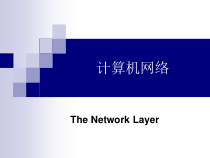 PPT
PPT
【文档说明】计算机网络第五版(英文版)(5)解析课件.ppt,共(75)页,3.546 MB,由小橙橙上传
转载请保留链接:https://www.ichengzhen.cn/view-5447.html
以下为本文档部分文字说明:
计算机网络TheNetworkLayerTheNetworkLayerTopicsNetworkLayerDesignIssuesStore-and-ForwardPacketSwitchingImplementationofConnectionlessServiceImplementati
onofConnection-OrientedServiceComparisonofVirtual-CircuitandDatagramSubnetsRoutingAlgorithmsCorrectnessSimplicityRobustnessStabilit
yFairnessOptimalityRoutingAlgorithmsShortestPathRoutingFloodingDistanceVectorRoutingLinkStat
eRoutingHierarchicalRoutingRoutingAlgorithmBasicsTheroutingalgorithmisthatpartofthenetworklayersoft
wareresponsiblefordecidingwhichoutputlineanincomingpacketshouldbetransmittedon.Ifthesubnetusesdatagramsinte
rnally,thisdecisionmustbemadeanewforeveryarrivingdatapacketsincethebestroutemayhavechangedsincelasttime.Ift
hesubnetusesvirtualcircuitsinternally,routingdecisionsaremadeonlywhenanewvirtualcircuitisbeingsetup.RoutingAlgorith
mBasics(2)AlloptimalroutesfromstationAtootherstationsinthenetwork,jointlyconstituteasinktreeRoutershavetoco
llaboratetobuildthesinktreeforeachsourcestationordestinationstation.RoutingAlgorithmBasics(3)MetricsusedforoptimizationDis
tanceNumberofhopsTimedelayTwomajorclassesofroutingalgorithmsNonadaptiveorStatic:theroutingtableiscomputedinadvance,off-line,anddownl
oadedtotherouterswhenthenetworkisbooted.AdaptiveorDynamic:changetheirroutingdecisionstoreflectchangesinthetopol
ogy,andusuallythetrafficaswell.ShortestPathRoutingIdea:buildagraphofthesubnet,witheachnodeofthegraphrepresentingarouterandeacharcoftheg
raphrepresentingacommunicationline.Tochoosearoutebetweenagivenpairofrouters,thealgorithmjustfindstheshortestpathbetweenthemonthegraph.thelabels
(weights)onthearcscouldbecomputedasafunctionofthedistance,bandwidth,averagetraffic,communicationcost,measureddelay,andotherfactors.ShortestPa
thCriteria:sumoftheweightsalltheway,or,thenumberofhops.ShortestPathRoutingDijkstraAlgorithmBasicIdea:dur
ingeachstep,selectanewlyreachablenodeatthelowestcost,andaddtheedgetothatnode,tothesinktreerootedatthesourcen
odebuiltsofar.FloodingBasicidea:Forwardanincomingpacketacrosseveryoutgoingline,excepttheoneitcamethrough.Basicproblem
:howtoavoid―drowningbypackets‖?Useahopcounter:afterapackethasbeenforwardedacrossNrouters,itisdiscarded.Besuretoforwardapacke
tonlyonce(i.e.avoiddirectedcycles).Requiressequencenumberspersourcerouter.Floodselectively:onlyinthedirectionthatmakessense.Floodingma
kessenseonlywhenrobustnessisneeded,e.g.inmilitaryapplicationsDistanceVectorRoutingBellman-FordorFord-
FulkersonalgorithmDistanceVectorRoutingAlgorithms:eachroutermaintainsatable(i.e,avector)givingthebestknowndistancetoeachdestinationandwhi
chlinetousetogetthere,whichareupdatedbyexchanginginformationwiththeneighborsperiodically.UpdatingProcess:Ta
kealookatthecoststhatyourdirectneighborsareadvertisingtogetapackettothedestination.Selecttheneighborwhoseadvertisedcost,addedwiththecostt
ogettothatneighbor,isthelowest.Advertisethatnewcosttotheotherneighbors.InDVR,thereistheproblemofcount-to-inf
inityinthepresenceofnodecrashes.DVRExample(a)Asubnet.(b)InputfromA,I,H,K,andthenewroutingtableforJLinkStateRoutingLinkSt
ateRouting:broadcastinfoontheentirenetworktopologytoallrouters,andleteachofthemcalculateasinktreetotheother
routers.Eachroutermustdothefollowing:Discoveritsneighbors,learntheirnetworkaddress.Measurethedelayorcosttoeachofit
sneighbors.Constructapackettellingallithasjustlearned.Sendthispackettoallotherrouters.Computetheshortestpathtoeveryotherrouter.
MeasuringLineCostJustsendanECHOpacketthrougheachinterface,andmeasuretheround-tripdelay.That’llgiveyouareasona
bleestimateoftheactualdelay.Whethertotaketheloadintoaccountwhenmeasuringthedelay?Yes:thetimershouldb
estartedwhentheECHOpacketisqueued.Youmayredirecttrafficinsuchawaythatthealternativerouteisunloaded.No:thetimershouldbestartedwhentheE
CHOpacketreachesthefrontofthequeue.Theshortestpathyouchoosemaybeoverloaded.BuildingLinkStatePacketsThepacketstartswiththeidentityofthesender,follow
edbyasequencenumberandage,andalistofdualitems(neighbor,thedelaytoit).Thehardpartiswhentobuildthem,atregularintervalsorwhensomesignifica
nteventoccurs?Practiceshowsthatonceanhourisoftenenough.DistributingtheLinkStatePacketsUseafloodingalgorithm,anddamthefloodthroughseq
uencenumbers:allroutersmaintainalistof(source,seqnumber)-pairs.Tosafeguardagainstolddata,downlinks,etc.anageisaddedtoanLSP.
Theageisdecrementedonceasecond,andeverytimeitisforwardedbyarouter.Whentheagehitszero,theLSPisdiscarded.Toguardagainster
rorsontherouter-routerlines,alllinkstatepacketsareacknowledged.GoodsandBadsofLSRGoodsGoodconsistencyofeachrouterinformationQu
ickconvergenceforgoodandbadnewsBadsEachrouterneedlargememorytostoretheinputlinkstatesofotherroutersThecomputationtime
canbeanissueHierarchicalRoutingProblem:Noroutingalgorithmdiscussedsofarcanscale:allofthemrequireeachroutertoknowaboutallothers=>toodemandingwit
hrespecttomemorycapacityandprocessingpower.Goforsuboptimalroutesbyintroducinghierarchicalroutingandregions,andsepa
ratealgorithmsforintra-regionandinter-regionrouting.Example:HierarchicalRoutingMulticastingroutingMOSPFDVMRPCBTNextdiscussiontopicsMu
lticastingroutingAdhocroutingBroadcastingroutingMobilehostsroutingCongestionControlAlgorithmsGeneralPrincipleso
fCongestionControlCongestionPreventionPoliciesCongestionControlinVirtual-CircuitSubnetsCongestionControlinDatagramSubnetsLoadShedd
ingJitterControlCongestionCongestion:Whentoomanypacketsarepresent,performancedegradesAtveryhightraffic
,performancecollapsescompletelyandalmostnopacketsaredelivered.CongestionGeneralPrinciplesofCongestio
nControlTwogroupsofsolutions:Openloop:attempttosolvetheproblembygooddesign,inessence,tomakesureitdoesnotoccurinthefirstplace.Closedloop:arebas
edontheconceptofafeedbackloop.Monitorthesystemtodetectwhenandwherecongestionoccurs.Passinformationtowhereactioncanbetaken.Adjusts
ystemoperationtocorrecttheproblem.PolicyCongestionControlinVirtual-CircuitSubnetsHop-by-HopChokePacketsWhenarouterruns
outofitsresources,itsendsachokepacketbacktothesourcehost,givingitthedestinationfoundinthepacket.Whenthesourcehostgetsthechokepacket,itw
illslowdownthetrafficsenttothespecifieddestination.Hop-by-Hop:thechokepacketaffectseveryhopitpasses
through.(a)Achokepacketthataffectsonlythesource.(b)Hop-by-Hopchokepacket.RandomearlydetectionByhavingroutersdroppackets
beforethesituationhasbecomehopeless(hencethe''early''inthename),theideaisthatthereistimeforactiontobetakenbeforeitistoolate.Todeterminewhent
ostartdiscarding,routersmaintainarunningaverageoftheirqueuelengths.Whentheaveragequeuelengthonsomeline
exceedsathreshold,thelinkissaidtobecongestionandasmallfractionofthepacketsaredroppedatrandomJitterCont
rolQualityofServiceAstreamofpacketsfromasourcetoadestinationiscalledaflow.Inaconnection-orientednetwork,allthepack
etsbelongingtoaflowfollowthesameroute;inaconnectionlessnetwork,theymayfollowdifferentroutes.Theneedsofeachflowcanbecharacteriz
edbyfourprimaryparameters:reliability,delay,jitter,andbandwidth.TogetherthesedeterminetheQoS(Quality
ofService)theflowrequires.TrafficShapingTrafficshapingisaboutregulatingtheaveragerateofdatatransmission.
Thegoalistoallowapplicationstotransmitawidevarietyoftrafficthatsuitstheirneeds,includesomebursts.TheLeakyBuc
ketAlgorithmImagineabucketwithasmallholeinthebottom.Nomattertherateatwhichwaterentersthebucket,theoutflowisataconstantrate,,
whenthereisanywaterinthebucketandzerowhenthebucketisempty.*实现:-对定长分组的实现:以分组为单位;-对变长分组的实现:采用字节计数法。漏桶算法(续):*举例:设计算机以25MB/s速率产生数据,路由器长时间的最
佳工作速率不超过2MB/s。数据以每秒中有40ms,1MB的突发数据输入。为平稳输出,使用一个ρ=2MB/s,容积C=1MB的漏桶。a图为漏桶的输入,b图为漏桶的输出。TheTokenBucketAlgorithmThe
leakybucketalgorithmenforcesarigidoutputpatternattheaveragerate,nomatterhowburstythetrafficis.Formanyapplications,itisbettertoa
llowtheoutputtospeedupsomewhatwhenlargeburstsarrive,soamoreflexiblealgorithmisneeded,preferablyonethatneverlose
sdata.Onesuchalgorithmisthetokenbucketalgorithm.通信量整形—令牌桶算法:*实现:-采用分组计数法:设置令牌计数器,每隔ΔT加1,每发送一个分组减1,计数器为0时停止发送。-采用字节计数法:时钟每隔ΔT令牌计数器加k字节,每发送一个分组减该分组
长度。*对突发时间长度的限制:设突发时间长度S秒,令牌桶容量B字节,令牌到达率R字节/秒,最大速率M字节/秒,由B+RS=MS得S=B/(M-R)。通信量整形—令牌桶算法:*对突发长度的限制(续):例:容量C分别是250KB、500KB和750KB,ρ=2MB,M=25MB/
s。假定当1MB突发数据到达时,令牌桶已满。5.4.2实现高QoS的技术(续)资源预留:•可能被预留资源的种类:-带宽-缓冲区空间-CPU时钟周期AdmissioncontrolAdmissioncontrol
:•确定接收或拒绝一个流并非易事,原因:-由于有些应用可能知道带宽需求,但不知道缓冲区和CPU时钟周期的需求。-有些应用需要更高的容错能力。-有些应用希望讨价还价流的参数。Admissioncontrol•flowspecifi
cation(流说明):-能够准确描述规范化的流参数。-从源端到目的端沿途路由器可修改这些参数。举例:-令牌桶速率:长时间间隔的平均输入桶的每秒字节数。-令牌桶容量。-峰值数据速率:限制短暂时间间隔发送速率。-最小、最大分组长度:含头部。Pa
cketsscheduling按比例路由:由于路由器一般不了解整个网络的流量,一种高QoS的方法是根据输出链路能力按相等或比例划分,在多条路径上传输。Packetsscheduling:•公平队列算法:*Nagle算法:-到达分组按分类或流进入各自队列;-轮流从各队列输出,一旦某队列空,立即从
非空队列输出。Packetsscheduling分组调度(续):•公平队列算法(FIFO)•加权队列算法(WFQ)5.4.2实现高QoS的技术(续)分组调度(续):•加权公平队列(WFQ):-对不同的队列设置优先级(即权重)。-按权重比例发
送。5.4.2实现高QoS的技术(续)分组调度(续):•令牌+WFQ提供可证明的最大队列延时:n条流的令牌桶+WFQ队列模型。b1r1bnrnw1wnInternetworkingHowNetworksDifferHowNetworksCanBeConnectedConc
atenatedVirtualCircuitsConnectionlessInternetworkingTunnelingFragmentationConnectingNetworksHowNetworksDifferHowNet
worksCanBeConnectedRepeatersatthephysicallayerforboostingsignals.Bridgestomaketheinterconnectionatthedatalinklayer.Multiproto
colroutersforforwarding,andpossiblysplittinguppackets(bridgescan’tdothelatter).Transportgatewaysforinterfacingbetweentwotr
ansportconnections.Applicationgateways,translatemessagesemantics.ConcatenatedVirtualCircuitsConnectionlessinter
networkingHavethenetworklayerofferonlydatagramservices:unreliable,unorderedpacketflow.Mainproblem:Addressing–differen
tnetworksusecompletelydifferentaddresses,sohowdoIaddressahostinanIPnetworkwhenI’veonlygotSNA?Solution:consider,usingIPasauniversal
networkprotocolTunnelingWecansolvealotoftheinternetworkingproblemswhenwecanassumethatthesourceanddestinatio
nofthesametypeofnetworkisconnectedbydifferentnetwork,weneedonlytotunnelpacketsthroughintermediatenetworks.Fra
gmentationFragmentation:Differentnetworksmayimposedifferentmaximumpacketsizes.Thismeansthatwemayhavetosplitapacketintosmalleroneswhenforwardingi
tthroughanetworkwhosemaximumpacketsizeistoosmallWheretoreassemblethefragments?Gateway:TransparentfragmentationThe
destinationhost:NontransparentfragmentationTheNetworkLayerintheInternetTheInternetProtocol(IP)TheInternetisacollectionofmanyne
tworksconnectedtogetherbyabunchofbackbones.ThegluethatholdsthewholeInternettogetheristhenetworklayerprotocol,IP(InternetProtocol).TheIPv4Header
TheIPv4Header(2)AddressesIPAddresses(2)Subnets(1)Allhostsonthesamenetworkmusthavethesamenetworknumber.Thismaycauseasingleorganization
toacquireseveralclassesofaddressesformultipleLANs.Useasinglenetworkaddressfortheentireorganization,andinternallydividethehostaddressspaceint
oasubnetaddressandahostidToimplementsubnetting,themainrouterneedsasubnetmaskthatindicateCIDR–ClasslessInt
erDomainRoutingCIDR–ExamplesCIDR–AggregateEntriesFormanyroutersoutside194.24.0.0,theonlythingtheyseeisthat
thereare(atleast)3networkaddressesforwhichpacketsfollowthesameroute.Theseentriescanbeaggregatedintoasingleentry194.24.0.
0/19withasinglesubmaskof19/131/0bits.
 辽公网安备 21102102000191号
辽公网安备 21102102000191号
 营业执照
营业执照